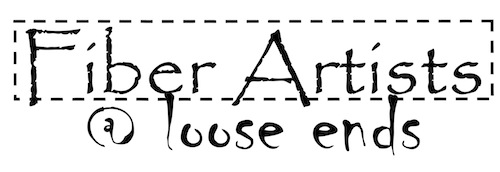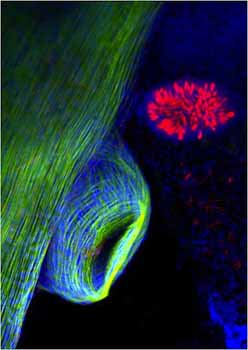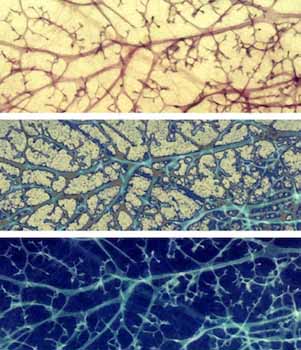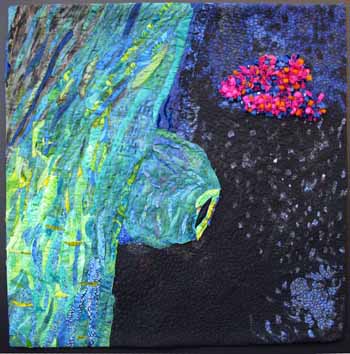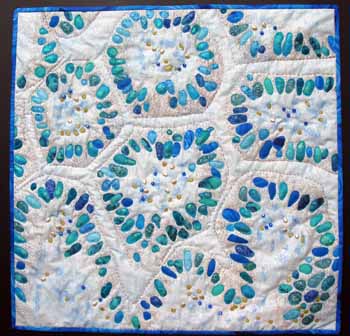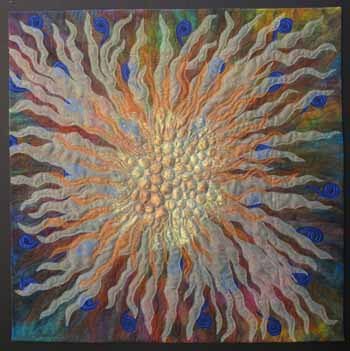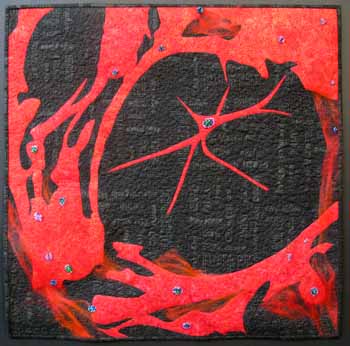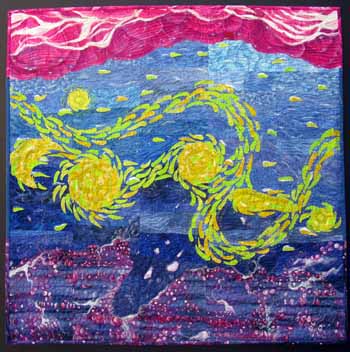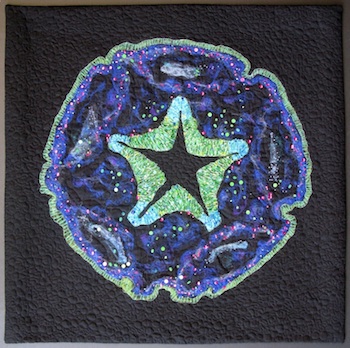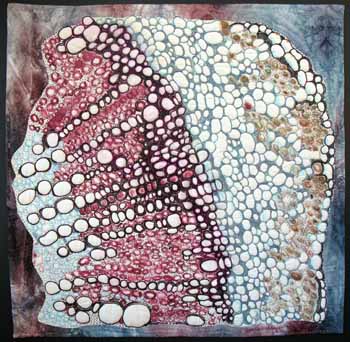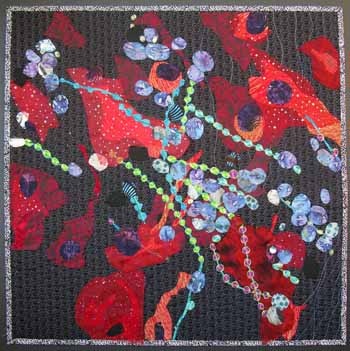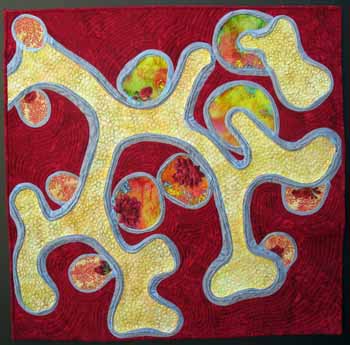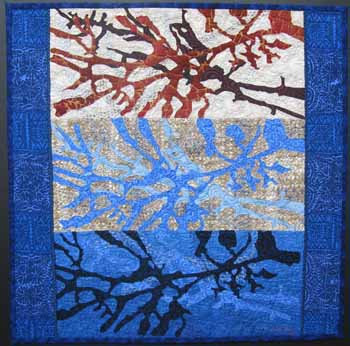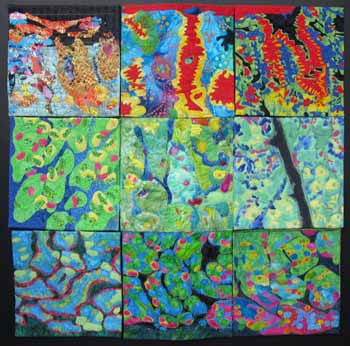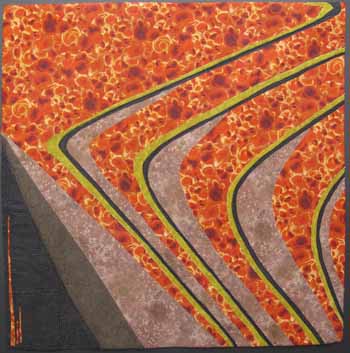Click to enlarge quilt images.
|
Calimari by Annabel Ebersole
Nerve studies resonate with me as my Dad died from Alzheimer's. Our human body is an amazing working universe and these studies that illuminate possible "fixes" are filled with hope. I have painted the background with colored pencils, oil paint sticks and liquid paint. Using wool, silk, cotton, ultra suede and rayon fabrics has made the long blue green fibers and pinky- explosive spot stand out. Bravo to these research efforts!! |
Calimari
by Andy Chervenak, Graduate Student, Cell and Developmental Biology
The green structure in this picture is the siphon of a marine squid. The siphon sucks water into the squid and then rapidly expels it to propel the squid through the ocean. Surrounding muscles can change the direction of the jet of water, so that the squid can control its direction. Thus, the squid is a wonderful model for the study of muscle development and function, but it is more well known for another specialization, its giant axon, or nerve fiber, that is 1,000 times wider than the axons present in humans. For nearly a century, scientists have studied the squid giant axon to understand how nerves conduct electricity and how nerve cells communicate with muscle and with other nerve cells. Disturbances in these nerve communication functions are responsible for the symptoms in Alzheimer's Disease and other adult-onset neurodegenerative diseases, such as Parkinson's and ALS. |
| Aztec Villi by Donna DeSoto
We've just experienced one of the hottest summers on record in the DC metropolitan area. No wonder that this image drew me in: working with various hand-dyed and cotton fabrics of many hues of blue-green and turquoise in my air conditioned home was a welcome respite from the heat and humidity outside. I used Caran d'Ache Neocolor Aquarelle Crayons to achieve effects of the blurred epithelial cells, and highlighted areas of villi with Jacquard Lumiere fabric paint and glitter. This piece is dedicated to our good family friend, John Dreska, and my quilting buddies Mary Lois Davis, Betsy Smith and Dana Hancock, who all suffer from Celiac disease. |
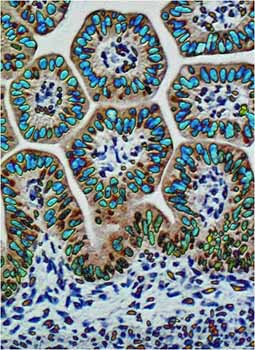
Aztec Villi
by Aaron Udager, MD/PhD Graduate Student, Cell and Developmental Biology
This is an image of a fetal mouse intestine. The brown cells with blue nuclei are intestinal epithelial cells. In the adult animal, these cells will be responsible for the processing and uptake of nutrients in the gut. Because the intestine needs a huge surface area for proper absorption, the epithelium is thrown into folds, called villi. Stem cells are located at the base of each villus and are responsible for replacing the entire epithelium every 3-4 days. The final surface area of the intestine in an adult human is approximately 2,000 square feet, bigger than many houses! Loss of villi occurs in Celiac disease, leading to malabsorption. |
|
Thistle by Barbara Hollinger
The hand dyed and hand painted background has been overlaid with several iridescent layers of sheer fabric, threads and fibers allowing the flash of color and light to come through hoping to capture the electricity pulsing between these neural cells sending each other signals for motion, for thought, of joy and of pain. |
 Thistle
by Maria Morrell, Ph.D., Postdoctoral Research Fellow, Cell and Developmental Biology
The goal of our research is study the potential of neural stem cells for repair after injury to the central nervous system. Certain regions of the adult brain contain neural stem cells that have the capability to form all types of neural cells: neurons (nerve cells), astrocytes (supporting cells) and oligodendrocytes (myelin forming cells). In this micrograph a spherical cluster of neural stem cells was stained to identify protein typically found in neurons (green) or astrocytes (orange). The nuclei of the cells have been stained blue. |
| Curious by Mary Lois Davis
My inspiration was Maria Morrell's photograph of "Curious" with its fabulous red/orange on black coloring with little specks of blue, green and pink. The black background of this piece has screen-printed words taken from Dr. Morrell's description of the slide: brain, glia, cell nuclei, neural stem cells, and so on. The red cell structures were created with raw-edge appliqué and free motion stitching along with needle felting to apply wool roving to create the wispy bits. Some of the red stitching was done using hologram thread. The colorful specks are represented with bead clusters. |
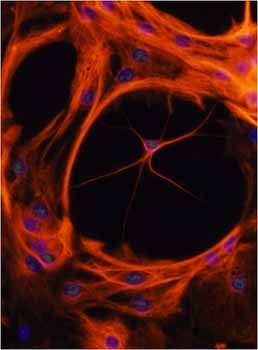
Curious
by Maria Morrell, Ph.D., Postdoctoral Research Fellow, Cell and Developmental Biology
Adult neural stem cells are present in several discrete locations in the brain. We are interested in how these cells can be directed to replace neurons and glia (supporting cells) lost due to injury, disease or normal aging. These neural stem cells were removed from an adult mouse brain, grown in tissue culture and induced to differentiate into glial cells; the supporting cells of the nervous system. The processes of the many glial cells are red. The round blue structures are cell nuclei. |
| Van Gogh's Skin by Carole Nicholas
"Van Goghs Skin: The photograph under the microscope which inspired this piece surely is reminiscent of the now iconic Van Gogh's"The Starry Night". I tried to imitate in fabric and stitching Van Gogh's bursts of brushwork to create all the swirling movement he captured with paint. |
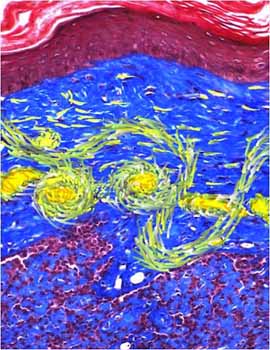
VanGogh's Skin
by Mark Hutchin, House Officer, Dermatology
This image shows a basal cell carcinoma, the most common form of skin cancer. The top portion shows the normal skin surface of a mouse, which stains red with this special stain (Masson trichrome stain). The blue is collagen, a strong fibrous substance that provides structural support for the skin. The appearance of human skin is very similar to this. At the bottom of the image, red staining tumor cells are seen. The yellow has been added for visual interest by the artist. By studying the development of tumors in the mouse, we hope to learn how to prevent the formation of similar tumors in humans. |
|
Stem Star by Lisa Ellis
This image spoke to me with its bright colors and similarities with creatures one might find down at the beach at our summer home in California. I used a combination of needle punch felting, bobbin thread painting and a variety of threads and beads. |
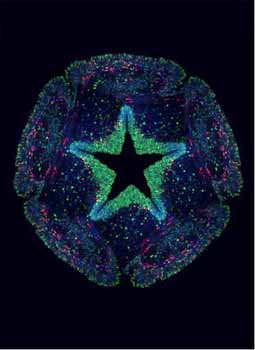 Stem Star
by Shannon Davis, Ph.D., Research Investigator, Human Genetics
This is a section of a mouse pituitary gland and nearby neural tube that has been artificially transformed into a star pattern. The neural tube forms the central star, while the pituitary is the bottle-cap shaped structure on the outside of the "stem star". The name, Stem Star, was given because both the neural tube and the pituitary contain stem cells that are responsible for the growth and maintenance of the two organs. The pituitary gland actually derives (in part) from the neural tube; the pituitary is a master gland that controls the activity of other glands that regulate growth, pregnancy, water balance, energy metabolism, blood pressure and the body's response to stress. |
|
Mellow by Sandi Goldman
I could instantly see the creative possibilities in "Mellow". I was connected to the circles, the texture, the rhythm, and the soft colors in the image. But when do I stop the embroidery, the painting, the drawing-is it finished? When does the research end? When will there be a cure, a breakthrough, an answer? This exemplifies the link between art and life, the intertwining of research and art. |
 Mellow
by Matthew Velkey, Ph.D., Lecturer, Cell and Developmental Biology
Some of the first studies of cells were done in plant tissues. In fact, Robert Hooke first coined the term "cell" in 1665 based on his examination of thin slices of cork under the microscope. Hooke observed thousands of tiny compartments within the cork tissue reminiscent of the tiny rooms, or cells, of a monastery. This image shows a stem of the industrial hemp plant, Cannabis sativa, cut in cross section, revealing the numerous vessels, made up of cells connected end-to-end, that transport nutrients and water. The section is NOT stained, so the colors present are due to natural pigments in the plant. The stem of a hemp plant contains an inner, woody pith, or hurd, made up of xylem vessels (red), which transport water. The outer layer, or bast, contains phloem vessels (aqua) that transport sugars made in the leaves. The bast fiber bundles (greenish-red bundles) located in the outer layer are very strong and are used to make hemp products such as textiles and rope. This subspecies of Cannabis has a relatively low concentration of tetrahydrocannabinol, the psychoactive component found in marijuana. |
| Internet by Judy Busby
My quilt is a rendition of Maria Morrell's research photograph of adult neural cells of mice. I am thankful to have permission to use Ms. Morrell's remarkable photograph!
The background is machine quilted with hand-sewn embellishments that include: Czech glass beads, Swarovski crystals, marbled beads and embroidered French knots. Layers of tulle and satin fabrics are hand sewn with raw edge appliqué.
As Ms. Morrell and her fellow scientists view this artwork, I hope they will feel the honor, respect, and thankfulness I feel for their dedication, hard work, and talent!
|

Internet
by Maria Morrell, Ph.D., Postdoctoral Research Fellow, Cell and Developmental Biology
Adult neural stem cells are present in several discrete locations in the brain. In our research we are interested in how these cells can be directed to replace neurons and glia (supporting cells) lost due to injury, disease or normal aging. These neural stem cells were removed from an adult mouse brain, grown in tissue culture and induced to differentiate into neurons and glial cells of the nervous system. Cell nuclei are blue, the glial cells are red, and processes of the neurons are green. |
|
Rosebud Kidney by Bunnie Jordan
This is a fabric interpretation of Dr Dressler's image entitled Rosebud Kidney. The hard science that may help us make progress against serious diseases is rendered using some of the softest fabrics, perhaps reflecting the delicate balance in this scientific work? I took license to represent some of the red cells of the nephron with cloth images of rosebuds and blooms as referenced in the title. The bright boundaries of the tubules are depicted by metallic trim and organza. |

Rosebud Kidney
by Greg Dressler, Ph.D., Professor of Pathology, Co-Director, Center for Organogenesis
This is an image of a mouse kidney at an early stage of embryonic development. The image illustrates the intimate relationships between cells of the nephron (red) and the branching collecting ducts (green). The purple/blue dye marks the boundary of each tubule and each new nephron from the surrounding space. Studying mouse kidney development can help us learn more about human kidney diseases such as Wilm's tumor and polycystic kidney disease. |
|
Branching by Paula Golden
Nurturing for life begins at the mother's breast and the importance of breast health cannot be stressed enough. The complex network of tissues that support the formation and delivery of milk in the mammary gland is portrayed via layers of hat and plastic vegetable netting, nylon tulle and commercial fabrics. Machine appliquéd and quilted. |
Branching
by Mara Steinkamp, Graduate Student, Human Genetics and Diane Robins, Ph.D., Professor, Department of Human Genetics
The mouse mammary gland consists of milk-producing alveolar cells and a network of ducts that transport the milk to the nipple. Beginning at puberty, ducts grow out from the nipple, invading the surrounding fat pad. Many of the factors important in development of the mammary gland may also be involved in breast cancer initiation and in subsequent tumor growth. In each image, ducts branch into the surrounding fat pads. The colors have been changed in each rendering. |
|
Gastric Rainbow
by Carole Nicholas, Judy Busby, Christine Adams, Bunnie Jordan, Paula Golden, Sandi Goldman, Barbara Hollinger, Mary Lois Davis, Annabel Ebersole
Nine artists independently interpreted a 10" section. Techniques are varied: fusing, raw edge appliqué, free-motion quilting, machine embroidery, silk waste overlay, zigzagged and turned edges. Materials; 100% cottons (also batiks, and artist dyed), Swarovski beads, acrylic paint, and watercolor pencils.
|
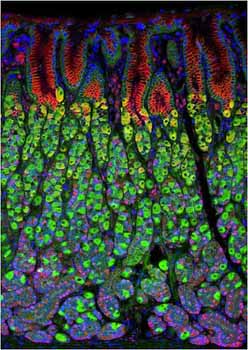
Gastric Rainbow
by Jochen Lennerz, M.D., Ph.D., Department of Pathology and Immunology, Washington University School of Medicine, St. Louis, MO and Jason Mills, M.D., Ph.D University of Washington at St. Louis
This is a section of a mouse stomach. Food will be digested in the black area at the top of the picture. The large green cells in the middle of the image produce stomach acid, while the cells at the bottom (highlighted in magenta) make digestive enzymes. The acid and enzymes are squirted up toward the food. The red cells at top line the surface of the stomach and secrete mucus. The mucus barrier protects these beautiful stomach cells from self-digestion. |
| Gradients by Christine Adams
The lovely lines of this image remind me of the plains and plateaus in the western part of the USA when viewed from afar. Getting closer we can see all sorts of wild life and flora. Instead of using solids I interpreted this image with a mix of patterned fabrics. It is my way of showing that very little is what it seems from far away. |
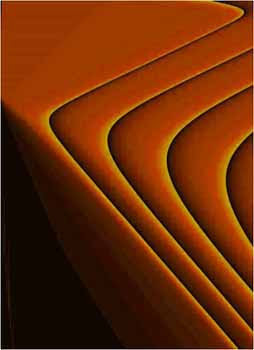
Gradients
by Edward Flach, Graduate Student, Mathematics
In 1952, Alan Turing proposed that the development of patterns in organisms could be modeled by a mathematical equation. Examples are simple to find: spots on leopards, stripes on fish and shells, even the coloring of pandas! With the possibility that mathematics could help to explain biology, there has been much investigation into this. We have been exploring the model in an abstract way, perturbing Turing's theory to examine its robustness. Here the horizontal axis is space; the left might be the head of an organism and the right the tail. The vertical axis is time, increasing from bottom to top. The morphogen expression is triggered at the beginning and an oscillatory pattern develops along the entire length of the animal. At high concentration of the morphogen, cells would fix a pigment. |

